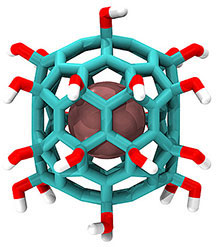| Oct 10, 2012 |
In silico, in vivo, in vitro approach opens doors for nanoparticle-based drug discovery
|
|
(Nanowerk News) The medical community is armed with new insights and new options for drug design and discovery to treat fatal diseases such as pancreatic cancer. Using in silico computational tools to complement the results of in vivo and in vitro experiments, researchers revealed an atomic-level understanding of the mechanism by which nanoparticles inhibit the growth and metastasis of pancreatic tumors ("Molecular mechanism of pancreatic tumor metastasis inhibition by Gd@C82(OH)22 and its implication for de novo design of nanomedicine").
|
 |
| Gd@C82(OH)22 is a spherical cage of carbon atoms (blue) with active hydroxyl groups dangling on the outside (red and white) and an atom of gadolinium trapped on the inside (purple). Originally developed for medical imaging, these nanoparticles now show promise for treating pancreatic cancer. (Image: IBM)
|
|
The nanoparticle type at the center of this study is gadolinium metallofullerenol, or Gd@C82(OH)22, which was originally developed for medical imaging applications such as MRI. Also central to the study are two popular anticancer therapy targets, MMP-2 and MMP-9. These MMPs, or matrix metalloproteinases, are key to the survival of cancer cells because they help bring a supply of blood vessels, and therefore oxygen and nutrients, to tumor sites.
|
|
Experiments showed that nanoparticle therapy blocked pancreatic tumor growth in mice and, at the cellular level, suppressed the expression and reduced the activities of MMP-2 and MMP-9. Computational simulations revealed that the nanoparticles’ action on MMP-9 is indirect such that they bind to the protein far from its active site. This is in distinct contrast to traditional molecular medicines that typically target the MMP active metal-binding site, directly blocking it or damaging the protein’s structure.
|
|
The nanoparticles were so effective that the team’s data suggest they may be a better pancreatic cancer therapy option than traditional medicines. Moreover, the team’s integrated use of computational theory to complement experimental data offers a new understanding, with unprecedented mechanistic detail, of the interactions between nanoparticles and biological molecules, bringing us into uncharted and promising new territory for drug design and discovery.
|

